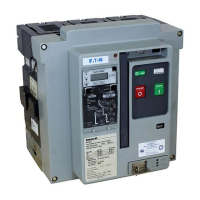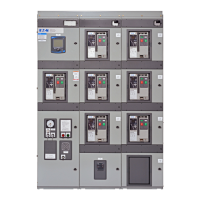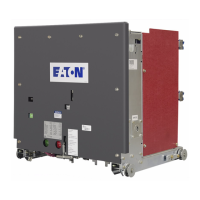50
Instructions for Installation, Operation and
Maintenance of Magnum SB Insulated Case
Low Voltage Power Circuit Breakers
EATON CORPORATION www.eaton.com
Instructional Leaet IB2C12063H03
Effective March 2012
Figure 66. Auxiliary Switch (2A/2B)
Table 9. Auxiliary Switch, Overcurrent Trip Switch and Cell Switch
Contact Ratings
Control
Voltages
Contact Rating
Inductive Load
(amperes)
250 Vac 10
125 Vdc 0.5
250 Vdc 0.25
Table 10. Undervoltage Release
Control
Voltages
Operational
Voltage Range
85-110%
Dropout
Volts
30-60%
j k
Inrush/Continuous
Power Consumption
Opening
Time (ms)
24 Vdc j 20-26 Vdc 7-14 Vdc 250 W/18 W 70
32 Vdc j 27-35 Vdc 10-19 Vdc 275 W/15 W 70
48 Vdc j 41-53 Vdc 14-29 Vdc 275 W/18 W 70
110-125 Vdc j 94-138 Vdc 33-75 Vdc 450 W/10 W 70
220-250 Vdc j 187-275 Vdc 66-150 Vdc 450 W/10 W 70
110-127 Vac k 94-140 Vac 33-76 Vac 450 VA/10 VA 70
208-240 Vac k 177-264 Vac 62-144 Vac 400 VA/10 VA 70
380-415 Vac k 323-457 Vac 114-249 Vac 480 VA/10 VA 70
480 Vac k 408-528 Vac 144-288 Vac 400 VA/10 VA 70
600 Vac k 510-660 Vac 180-360 Vac 400 VA/10 VA 70
j Required for 200 ms
k Required for 400 ms
Figure 67. Mechanical Trip Indicator with Associated Overcurrent
Trip Switch
Internal Electrical Accessories
Other electrical accessories are mounted inside the circuit
breaker. They can be factory or site installed. There are two
different internally mounted accessories:
• Overcurrent Trip Switch (Bell Alarm)
• Motor Operator
Overcurrent Trip Switch (Bell Alarm)
An overcurrent trip switch (bell alarm) is an optional device
(Figure 67). It provides an electrical indication when a
circuit breaker trips as a result of the trip unit reacting to an
overcurrent condition. Opening as a result of a circuit breaker’s
manual open button, shunt trip or undervoltage release
does not cause the overcurrent trip switch to operate. The
overcurrent trip switch has (2a 2b) Form C contacts (Table 9).

